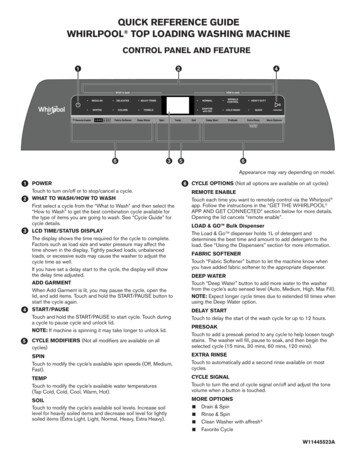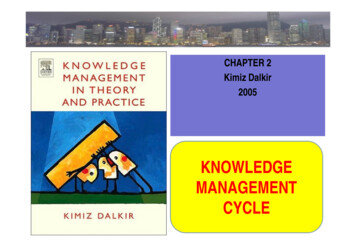
Transcription
Health Information National Trends Survey(HINTS) 5 Cycle 3 Data: A How-To Guide for Usingthe New Data in your ResearchBehavioral Research Program (BRP)Division of Cancer Control and Population Scienceshttps://cancercontrol.cancer.gov/brp
To ask a question Submit questions using the Q&A or Chat Panel andselect All Panelists You may need to activate the appropriate box using thefloating navigation panel found on the center of yourscreen The webinar recording will be posted in a few weeks atcancercontrol.cancer.gov/brpwebinars2
Webinar OverviewRichard Moser, Ph.D.Ashley Murray, Ph.D.Training Director and Research MethodsCoordinatorBehavioral Research ProgramCancer Research Training AwardFellowBehavioral Research Program3
Health Information National Trends Survey(HINTS) 5 Cycle 3 TutorialRichard P. Moser, Ph.D.Chief Methodologist, HINTS ProgramResearch Methods Coordinator, Behavioral Research ProgramNational Cancer InstituteAshley B. Murray, Ph.D.Cancer Research Training Award FellowBehavioral Research ProgramNational Cancer InstituteMarch 26, 2020.
Rapidly Changing Communication Environment
Rapidly Changing Communication Environment
HINTS History & TimelineHINTS IHINTS IIList-assisted RDD RDD-C.A.T.I. - C.A.T.I.WebN 6369N 5586HINTS IIIHINTS IVHINTS VPostal FramePostal FrameDual Frame: RDD - C.A.T.I. Postal SampleN 76744-14-24-34-4FDA-1n 3959 n 3630 n 3185 n 3677 n 37385-1 FDA-25-25-35-4n 5438 tbdn 3285 n 35042003 2004 2005 2006 2007 2008 2009 2010 2011 2012 2013 2014 2015 2016 2017 2018 2019 2020AppalachiaPuerto CancerCentersLetter RFA
HINTS History & TimelineHINTS IHINTS IIList-assisted RDD RDD-C.A.T.I. - C.A.T.I.WebN 6369N 5586HINTS IIIHINTS IVHINTS VPostal FramePostal FrameDual Frame: RDD - C.A.T.I. Postal SampleN 7674Data available now!4-14-24-34-4FDA-1n 3959 n 3630 n 3185 n 3677 n 37385-1 FDA-25-25-35-4n 5438 tbdn 3285 n 35042003 2004 2005 2006 2007 2008 2009 2010 2011 2012 2013 2014 2015 2016 2017 2018 2019 2020AppalachiaPuerto CancerCentersLetter RFA
HINTS History & TimelineHINTS IHINTS IIList-assisted RDD RDD-C.A.T.I. - C.A.T.I.WebN 6369N 5586HINTS IIIHINTS IVHINTS VPostal FramePostal FrameDual Frame: RDD - C.A.T.I. Postal SampleN 7674Data available now!4-14-24-34-4FDA-1n 3959 n 3630 n 3185 n 3677 n 37385-1 FDA-25-25-35-4n 5438 tbdn 3285 n 3504Currently in the field;available fall/winter, 20202003 2004 2005 2006 2007 2008 2009 2010 2011 2012 2013 2014 2015 2016 2017 2018 2019 2020AppalachiaPuerto CancerCentersLetter RFA
https://hints.cancer.gov/Access to: HINTS data and supportingdocuments Electronic codebook Tutorial Reports List of publications Briefs
Overview of HINTS 5 Cycle 3 Population: US Non-InstitutionalizedAdults (18 ) Conducted January to April 2019 Total N 5,438
Content
Web Pilot Test multi-mode survey Goal: Improve dataquality– Increase response rates– Increase coverage– Reduce undesirablerespondent behavior Non-completion Speeding Straight lining Assess cost effectiveness Random assignment into 3 groups– Paper only– Web option– Web bonus– All get 2 incentive in mail Web groups could answer oninternet or return by mail Prompting vs. no prompting (web) Considered as independent samplesfrom same population– Weights available for each
Web Pilot: ResultsGroupSample SizePaper Only3,37230.2%Web Option98629.6%Web Bonus1,08031.5%Total Sample5,43830.3%* Not statistically differentResponse Rate *
See For More Information
Conducting Analyses
Statistics Overview HINTS can be analyzed using a variety of programs When you are interested in conducting inferential statistics (i.e. anything thatinvolves calculating a p-value or confidence interval), it is important toconsider which program you use A program should be able to:– Compute the correct variance estimates when analyzing survey data thatemploy a complex sampling method (e.g. HINTS)– Analyze data using jackknife replicate weights OR Taylor Linearization
Statistics Overview Code and results for SAS, SPSS, and STATA are provided in the Overview of theHINTS 5 Cycle 3 Survey and Data Analysis Recommendations Document– Descriptive analyses, Chi Square, Logistic Regression, & Linear Regressionusing both Jackknife replicates and Taylor Linearization in SAS and STATA(SPSS can only use Taylor Linearization; code & results provided)– SPSS analyses use Complex Samples module (add-on to Base SPSS)– We suggest using a program that can integrate Jackknife replicate weightswhen possible Tutorial will highlight both SAS and SPSS
Determining and UsingWeights for AnalysesSAS and SPSS
Determining Weightsto Use forHINTS 5 Cycle 3
Conducting Analyses to Assess for Group Differences in SAS It is strongly recommended that analysts first assess for possible group differenceswithin their target variables.
Conducting Analyses to Assess for Group Differences in SAS It is strongly recommended that analysts first assess for possible group differenceswithin their target variables.Set negativevalues to missing
Conducting Analyses to Assess for Group Differences in SAS It is strongly recommended that analysts first assess for possible group differenceswithin their target variables.VarianceEstimation Method
Conducting Analyses to Assess for Group Differences in SAS It is strongly recommended that analysts first assess for possible group differenceswithin their target variables.VarianceEstimation MethodFinal andReplicateSampleWeights{
Conducting Analyses to Assess for Group Differences in SAS It is strongly recommended that analysts first assess for possible group differenceswithin their target variables.VarianceEstimation MethodFinal andReplicateSampleWeights{Replicate Weight DDF
Conducting Analyses to Assess for Group Differences in SAS It is strongly recommended that analysts first assess for possible group differenceswithin their target variables.VarianceEstimation MethodFinal andReplicateSampleWeights{Replicate Weight DDFGrouping Variable
SPSS Complex Samples
SPSS Complex Samples
SPSS Complex Samples
SPSS Complex SamplesControlling or Assessing forGroup Differences
SPSS Complex SamplesControlling or Assessing forGroup DifferencesFull Sample(No Group Differences)
SPSS Complex Samples
SPSS Complex Samples
Conducting Analyses to Assess for Group Differences in SPSS
Conducting Analyses to Assess for Group Differences in SPSS
Conducting Analyses to Assess for Group Differences in SPSS
ConductingAnalyses toAssess for GroupDifferences inSPSS
ConductingAnalyses toAssess for GroupDifferences inSPSS
Determining Weightsto Use forHINTS 5 Cycle 3
Determining Weightsto Use forHINTS 5 Cycle 3
Conducting Analyses Using Only One Groupproc surveylogistic data DATAFILENAME varmethod jackknife;weight tg1 finwt0;repweights tg1 finwt1-tg1 finwt50 /df 49 jkcoefs .98;*Predictor# variables in model statement are placeholdersto substitute with your desired predictors;model SeekCancerInfo predictor1 predictor2predictor3 predictor4 ;run;Note: example code above is for the paper-only sample (“TG1”). Weight and repweight statements may be replaced with the“TG2” weights for the web option sample or “TG3” weights for the web bonus sample.
Determining Weightsto Use forHINTS 5 Cycle 3
Conducting Analyses Combined Sample,Controlling For Group Differences Logistic Regressionproc surveylogistic data DATAFILENAME varmethod jackknife;weight nwgt0;repweights nwgt1-nwgt150 /df 147 jkcoefs .98;*Predictor# variables in model statement are placeholders to substitutewith your desired predictors;model SeekCancerInfo TREATMENT H5C3 predictor1 predictor2 predictor3predictor4 ;run; Linear Regressionproc surveyreg data DATAFILENAME varmethod jackknife;weight nwgt0;repweights nwgt1-nwgt150 /df 147 jkcoefs .98;*Predictor# variables in model statement are placeholders to substitutewith your desired predictors;model GeneralHealth TREATMENT H5C3 predictor1 predictor2 predictor3predictor4 /solution;run;
ConductingAnalysesCombinedSample,Controlling ForGroup Differences
ConductingAnalysesCombinedSample,Controlling ForGroup Differences
Conducting Analyses on the Combined Sample,Without Controlling for Group DifferencesIf no group differences are found, it is suggested that analysts use the combined sample toincrease statistical power Frequency Table and Chi-Square Testproc surveyfreq data hints5cycle3 varmethod jackknife;weight TG all FINWT0;repweights TG all FINWT1-TG all FINWT50 / df 49 jkcoefs 0.98;tables edu*gender / row col wchisq;run; Logistic Regression/*Multivariable logistic regression of gender and education on SeekCancerInfo*/proc surveylogistic data hints5cycle3 varmethod jackknife;weight TG all FINWT0;repweights TG all FINWT1-TG all FINWT50 / df 49 jkcoefs 0.98;class edu (ref "Less than high school")gender (ref "Male")/param REF;model seekcancerinfo (descending) gender edu /tech newton xconv 1e-8 CLPARM EXPB;run; Linear Regression/*Multivariable linear regression of gender and education on GeneralHealth*/proc surveyreg data hints5cycle3 varmethod jackknife;weight TG all FINWT0;repweights TG all FINWT1-TG all FINWT50 / df 49 jkcoefs 0.98;class edu (ref "Less than high school") gender (ref "Male");model generalhealth edu gender /solution;run;
ConductingAnalyses on theCombinedSample,WithoutControlling forGroup Differences
Combining Cycles
Merging HINTS Survey Iterations Analysts should first assess for group differences in the HINTS 5, Cycle 3 data onvariables of interestSample code is created assuming there are no differences between groups in HINTS 5Cycle 3If group differences are found:– Create a new variable in both data files that would allow the analyst todifferentiate between the 4 groups(H5C2, H5C3 Paper Only, H5C3 Web Option, and H5C3 Web Bonus groups)– Use the Rizzo, et al., (2008) method to create 200 replicate weights
Merging HINTS Survey Iterations Using SAS/*FIRST CREATE THE FORMAT FOR THE SURVEY VARIABLE*/proc format;value survey1 "HINTS 5 CYCLE 2"2 "HINTS 5 CYCLE ********************************//*CREATE TWO SEPARATE TEMPORARY DATA FILES THAT CONTAIN THE NEW ‘SURVEY’VARIABLE.*//*PUT NAME OF LIBRARY WHERE HINTS 5 CYCLE 2 FORMATS ARE STORED*/;options fmtsearch (LibH5C2);data tempHINTS5CYCLE2;/*PUT NAME OF LIBRARY AND NAME OF EXISTING HINTS 5 CYCLE 3 DATA FILE*/set LibH5C2.DataH5C2;survey 1;format survey survey.;run;/* PUT NAME OF LIBRARY WHERE HINTS 5 CYCLE 3 FORMATS ARE STORED*/options fmtsearch (hints5c3);data tempHINTS5CYCLE3;/*PUT NAME OF LIBRARY AND NAME OF EXISTING HINTS 5 CYCLE 3 DATA FILE*/set hints5c3.hints5cycle3 formatted;survey 2;format survey survey.;run;
Merging HINTS Survey Iterations Using SAS/*FIRST CREATE THE FORMAT FOR THE SURVEY VARIABLE*/proc format;value survey1 "HINTS 5 CYCLE 2"2 "HINTS 5 CYCLE 3";run;}Format for new variableto differentiate ************************************//*CREATE TWO SEPARATE TEMPORARY DATA FILES THAT CONTAIN THE NEW ‘SURVEY’VARIABLE.*//*PUT NAME OF LIBRARY WHERE HINTS 5 CYCLE 2 FORMATS ARE STORED*/;options fmtsearch (LibH5C2);data tempHINTS5CYCLE2;/*PUT NAME OF LIBRARY AND NAME OF EXISTING HINTS 5 CYCLE 3 DATA FILE*/set LibH5C2.DataH5C2;survey 1;format survey survey.;run;/* PUT NAME OF LIBRARY WHERE HINTS 5 CYCLE 3 FORMATS ARE STORED*/options fmtsearch (hints5c3);data tempHINTS5CYCLE3;/*PUT NAME OF LIBRARY AND NAME OF EXISTING HINTS 5 CYCLE 3 DATA FILE*/set hints5c3.hints5cycle3 formatted;survey 2;format survey survey.;run;
Merging HINTS Survey Iterations Using SAS/*FIRST CREATE THE FORMAT FOR THE SURVEY VARIABLE*/proc format;value survey1 "HINTS 5 CYCLE 2"2 "HINTS 5 CYCLE 3";run;}Format for new variableto differentiate ************************************//*CREATE TWO SEPARATE TEMPORARY DATA FILES THAT CONTAIN THE NEW ‘SURVEY’VARIABLE.*//*PUT NAME OF LIBRARY WHERE HINTS 5 CYCLE 2 FORMATS ARE STORED*/;options fmtsearch (LibH5C2);data tempHINTS5CYCLE2;/*PUT NAME OF LIBRARY AND NAME OF EXISTING HINTS 5 CYCLE 3 DATA FILE*/set LibH5C2.DataH5C2;survey 1;format survey survey.;Create new variable todifferentiate survey cyclerun;/* PUT NAME OF LIBRARY WHERE HINTS 5 CYCLE 3 FORMATS ARE STORED*/options fmtsearch (hints5c3);data tempHINTS5CYCLE3;/*PUT NAME OF LIBRARY AND NAME OF EXISTING HINTS 5 CYCLE 3 DATA FILE*/set hints5c3.hints5cycle3 formatted;survey 2;format survey survey.;run;Create new variable todifferentiate survey cycle
Merging HINTS Survey Iterations Using SASSAS Code to Set Up Final and Replicate Weights for the Replicate VarianceEstimation Method/*THIS CODE MERGES THE TWO TEMPORARY DATA SETS CREATED ABOVE. IT ALSO CREATES ONE FINAL SAMPLEWEIGHT (Merged NWGT0) AND 100 REPLICATE WEIGHTS (Merged NWGT1 THRU Merged NWGT100)*/data mergeHINTS5C2 HINTS5C3;set tempHINTS5CYCLE2 tempHINTS5CYCLE3;/*Create Replicate Weights for trend tests*/**Replicate Weights;array hints52wgts [50] person finwt1-person finwt50;array hints53wgts [50] TG all finwt1-TG all finwt50;array Merged NWgt [100] Merged NWGT1-Merged NWGT100;**Adjust Final And Replicate Weights;if survey eq 1 then do i 1 to 50;*HINTS 5 CYCLE 2;Merged NWGT0 person finwt0;Merged NWgt[i] hints52wgts[i];Merged NWgt[50 i] person finwt0;end;else if survey eq 2 then do i 1 to 50; *HINTS 5 CYCLE 3;Merged NWGT0 TG all finwt0;Merged NWgt[i] TG all finwt0;Merged NWgt[50 i] hints53wgts[i];end;run;
Merging HINTS Survey Iterations Using SASSAS Code to Set Up Final and Replicate Weights for the Replicate VarianceEstimation Method/*THIS CODE MERGES THE TWO TEMPORARY DATA SETS CREATED ABOVE. IT ALSO CREATES ONE FINAL SAMPLEWEIGHT (Merged NWGT0) AND 100 REPLICATE WEIGHTS (Merged NWGT1 THRU Merged NWGT100)*/data mergeHINTS5C2 HINTS5C3;set tempHINTS5CYCLE2 tempHINTS5CYCLE3;/*Create Replicate Weights for trend tests*/**Replicate Weights;array hints52wgts [50] person finwt1-person finwt50;array hints53wgts [50] TG all finwt1-TG all finwt50;array Merged NWgt [100] Merged NWGT1-Merged NWGT100;}**Adjust Final And Replicate Weights;if survey eq 1 then do i 1 to 50;*HINTS 5 CYCLE 2;Merged NWGT0 person finwt0;Merged NWgt[i] hints52wgts[i];Merged NWgt[50 i] person finwt0;end;else if survey eq 2 then do i 1 to 50; *HINTS 5 CYCLE 3;Merged NWGT0 TG all finwt0;Merged NWgt[i] TG all finwt0;Merged NWgt[50 i] hints53wgts[i];end;run;Create ReplicateWeights
Merging HINTS Survey Iterations Using SASSAS Code to Set Up Final and Replicate Weights for the Replicate VarianceEstimation Method/*THIS CODE MERGES THE TWO TEMPORARY DATA SETS CREATED ABOVE. IT ALSO CREATES ONE FINAL SAMPLEWEIGHT (Merged NWGT0) AND 100 REPLICATE WEIGHTS (Merged NWGT1 THRU Merged NWGT100)*/data mergeHINTS5C2 HINTS5C3;set tempHINTS5CYCLE2 tempHINTS5CYCLE3;/*Create Replicate Weights for trend tests*/**Replicate Weights;array hints52wgts [50] person finwt1-person finwt50;array hints53wgts [50] TG all finwt1-TG all finwt50;array Merged NWgt [100] Merged NWGT1-Merged NWGT100;}Create ReplicateWeights**Adjust Final And Replicate Weights;if survey eq 1 then do i 1 to 50;*HINTS 5 CYCLE 2;Merged NWGT0 person finwt0;Adjust Final andMerged NWgt[i] hints52wgts[i];Merged NWgt[50 i] person finwt0;Replicate Weightsend;}else if survey eq 2 then do i 1 to 50; *HINTS 5 CYCLE 3;Merged NWGT0 TG all finwt0;Adjust Final andMerged NWgt[i] TG all finwt0;Replicate WeightsMerged NWgt[50 i] hints53wgts[i];end;run;}
Merging HINTS Survey Iterations Using SPSSSAVE OUTFILE 'H:\HINTS\5 Cycle 3\SPSS\MERGED H5C3 H5C2.sav'/COMPRESSED.DATASET NAME MERGED DATA.DATASET ACTIVATE MERGED DATA.COMPUTE MERGED FINWT0 TG all FINWT0.COMPUTE Survey 2.EXECUTE.
Merging HINTS Survey Iterations Using SPSSSAVE OUTFILE 'H:\HINTS\5 Cycle 3\SPSS\MERGED H5C3 H5C2.sav'/COMPRESSED.DATASET NAME MERGED DATA.DATASET ACTIVATE MERGED DATA.COMPUTE MERGED FINWT0 TG all FINWT0.COMPUTE Survey 2.EXECUTE.Save as new file
Merging HINTS Survey Iterations Using SPSSSAVE OUTFILE 'H:\HINTS\5 Cycle 3\SPSS\MERGED H5C3 H5C2.sav'/COMPRESSED.Rename DatasetDATASET NAME MERGED DATA.DATASET ACTIVATE MERGED DATA.COMPUTE MERGED FINWT0 TG all FINWT0.COMPUTE Survey 2.EXECUTE.Save as new file
Merging HINTS Survey Iterations Using SPSSSAVE OUTFILE 'H:\HINTS\5 Cycle 3\SPSS\MERGED H5C3 H5C2.sav'/COMPRESSED.Rename DatasetDATASET NAME MERGED DATA.DATASET ACTIVATE MERGED DATA.COMPUTE MERGED FINWT0 TG all FINWT0.COMPUTE Survey 2.EXECUTE.Save as new fileRename Final Sample Weight
Merging HINTS Survey Iterations Using SPSSSAVE OUTFILE 'H:\HINTS\5 Cycle 3\SPSS\MERGED H5C3 H5C2.sav'/COMPRESSED.Rename DatasetDATASET NAME MERGED DATA.DATASET ACTIVATE MERGED DATA.COMPUTE MERGED FINWT0 TG all FINWT0.COMPUTE Survey 2.Create aEXECUTE.Save as new fileRename Final Sample Weightvariable that allowsus to distinguish betweenparticipants from each cycle
Merging HINTS Survey Iterations Using SPSSSAVE OUTFILE 'H:\HINTS\5 Cycle 3\SPSS\MERGED H5C3 H5C2.sav'/COMPRESSED.DATASET NAME MERGED DATA.DATASET ACTIVATE MERGED DATA.COMPUTE MERGED FINWT0 TG all FINWT0.COMPUTE Survey 2.EXECUTE.**below, you should insert the filepath for your HINTS 5 Cycle 2 data**.GETFILE 'H:\HINTS\5 Cycle 2\HINTS-5 Cycle2 SPSS\hints5 cycle2 public.sav'.ALTER TYPE ALL(A AMIN).DATASET NAME H5C2 WINDOW FRONT.COMPUTE MERGED FINWT0 Person FINWT0.COMPUTE Survey 1.EXECUTE.
Merging HINTS Survey Iterations Using SPSSSAVE OUTFILE 'H:\HINTS\5 Cycle 3\SPSS\MERGED H5C3 H5C2.sav'/COMPRESSED.DATASET NAME MERGED DATA.DATASET ACTIVATE MERGED DATA.COMPUTE MERGED FINWT0 TG all FINWT0.COMPUTE Survey 2.EXECUTE.**below, you should insert the filepath for your HINTS 5 Cycle 2 data**.GETFILE 'H:\HINTS\5 Cycle 2\HINTS-5 Cycle2 SPSS\hints5 cycle2 public.sav'.ALTER TYPE ALL(A AMIN).DATASET NAME H5C2 WINDOW FRONT.Rename DatasetCOMPUTE MERGED FINWT0 Person FINWT0.Rename FinalCOMPUTE Survey 1.Create a variable that allowsEXECUTE.us to distinguish betweenparticipants from each cycleOpen other cycle dataSample Weight
Merging HINTSSurvey IterationsUsing SPSS
Merging HINTS Survey Iterations Using SPSS
For More Information
Questions?
Back Pocket Slides
SAS Taylor Linearization Frequencies and Chi Square, Combined Sample (No Differences Found)VarianceEstimation Method}Final SampleWeightStrata andCluster
Questions?74
Code and results for SAS, SPSS, and STATA are provided in the Overview of the HINTS 5 Cycle 3 Survey and Data Analysis Recommendations Document - Descriptive analyses, Chi Square, Logistic Regression, & Linear Regression using both Jackknife replicates and Taylor Linearization in SAS and STATA










